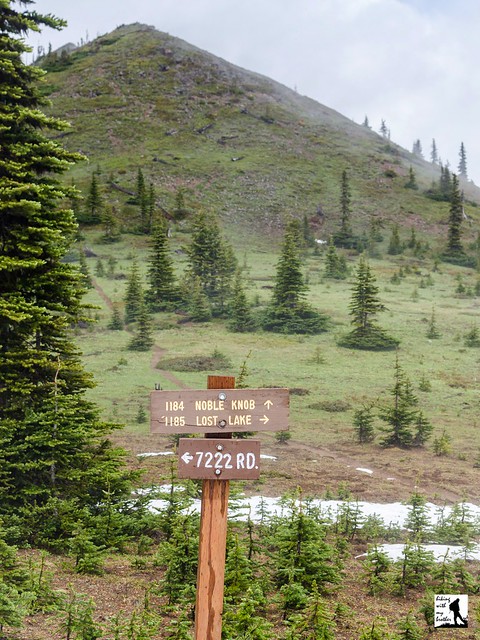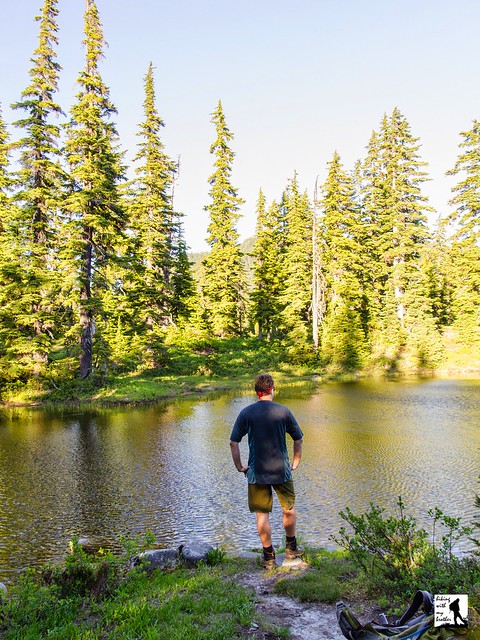Total Ascent: 3600ft
Highest Point: 6,011ft
Total Distance: 11.8 miles
Location: N 47° 1.6616, W 121° 29.4533
Required Permit: None
Difficulty: Hard
 Over the years we’ve found that many popular hiking destinations often have underused alternative approaches. Such approaches provide an opportunity to head back to a familiar mountaintop or alpine lake to expereince it in a whole new way. Recently, we found ourselves on one of these less-traveled trails climbing our way up Dalles Ridge to Noble Knob via the Deep Creek Trail #1196.
Over the years we’ve found that many popular hiking destinations often have underused alternative approaches. Such approaches provide an opportunity to head back to a familiar mountaintop or alpine lake to expereince it in a whole new way. Recently, we found ourselves on one of these less-traveled trails climbing our way up Dalles Ridge to Noble Knob via the Deep Creek Trail #1196.
There are quite a few Deep Creeks in Washington, most named for the gully or gorge the creek tumbles through. The Deep Creek on Dalles Ridge was named by the Forest Service presumably for a similar reason, though the trail does not spend much time near the creek to support this claim. While we were not able to locate much on the story behind the Deep Creek Trail, it seems likely that this more direct route was used to access the Noble Knob Fire Lookout from 1934 to 1956.
The hike begins from the White River Trailhead #1199, following the remains of an old road into a young forest of hemlock and vine maple. At .3 of a mile, the trail splits. Veer right and downhill for a few hundred feet to a footbridge crossing Deep Creek. Once across find the signed junction with the Deep Creek Trail #1196 and the first taste of the long climb to come. From here the route begins a series of long switchbacks carved into the shoulders of Dalles Ridge. Sheltered beneath a canopy of cedar and fir, the moss-lined trail is pleasant, quiet, and relentless. After a few miles, the trail forgoes switchbacks altogether, opting instead to plow steeply upslope. After nearly 4 miles of climbing, the trees begin to thin and the trail connects with the Noble Knob Trail #1184.
 From the junction, head left following the ridgeline as the trail turns north paralleling the Norse Peak Wilderness to the west, ever so briefly entering it for a few moments before leaving it again. You’ll know you went through the Wilderness when you pass the junction with the Dalles Ridge Trail #1173 in about a mile. Stay on the Noble Knob Trail to the next junction in a tenth of a mile. Here the trail splits in three directions. The path to the right is the Lost Lake Trail #1185, leading into the Wilderness and to the shores of Lost Lake. The trail to the left heads out to the other end of the Noble Knob Trail as well as a side trail leading down to Twentyeight Mile Lake. To reach the summit, take the middle path straight up to the top.
From the junction, head left following the ridgeline as the trail turns north paralleling the Norse Peak Wilderness to the west, ever so briefly entering it for a few moments before leaving it again. You’ll know you went through the Wilderness when you pass the junction with the Dalles Ridge Trail #1173 in about a mile. Stay on the Noble Knob Trail to the next junction in a tenth of a mile. Here the trail splits in three directions. The path to the right is the Lost Lake Trail #1185, leading into the Wilderness and to the shores of Lost Lake. The trail to the left heads out to the other end of the Noble Knob Trail as well as a side trail leading down to Twentyeight Mile Lake. To reach the summit, take the middle path straight up to the top.As you climb, the views only improve. Catch glimpses of Lost Lake to the west, and Twentyeight Mile Lake to the east. There is some confusion around the name of this lake – some USGS maps label it Twentymile Lake. Most likely the product of a typographical error somewhere along the line, the official name for this little lake is Twentyeight Mile Lake. Before you know it you will have reached the top and its 360-degree views. Mt. Rainier seems almost close enough to touch. Look north for your first view of George Lake in the meadow-filled cirque below you. Forested peaks spread out in every direction. Find a good place to settle in and see how many peaks you can name.
 This approach to Noble Knob is not for everyone. Where the Noble Knob Trail from Corral Pass involves only a modest 500 foot climb, the Deep Creek approach is a tough 3,600 foot slog. Unsurprisingly, most hikers opt for the easier approach, which makes this a great training hike or a good option if you’re looking for a little solitude on the trail. The Deep Creek Trail is also the winter approach to Noble Knob once the snows close off the forest roads leading up to Corral Pass.
This approach to Noble Knob is not for everyone. Where the Noble Knob Trail from Corral Pass involves only a modest 500 foot climb, the Deep Creek approach is a tough 3,600 foot slog. Unsurprisingly, most hikers opt for the easier approach, which makes this a great training hike or a good option if you’re looking for a little solitude on the trail. The Deep Creek Trail is also the winter approach to Noble Knob once the snows close off the forest roads leading up to Corral Pass. To get there, take I-5 south to Highway 18, Exit 142A. Follow Highway 18 into Auburn and take the SR 164 exit. Head left on SR 164 through Enumclaw to SR 410. Head left onto SR 410 and continue 31.2 miles through the town of Greenwater to the Corral Pass Road #7174 on the left. The road is unpaved. Follow #7174 for 1 mile to the White River Trailhead and a small parking area on the left side of the road at the end of a switchback. -Nathan
Print Google Directions >>










